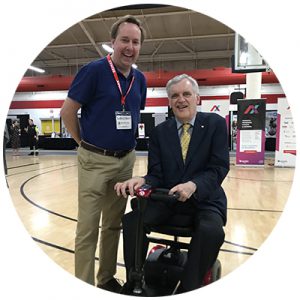QWhat inspired your focus on accessible housing?
A
Three people inspired my decision to focus on accessible housing: my mother, my aunt and Kevin Rogers.
My mom was an OT and physiotherapist and my aunt had MS and was a teacher. They both worked at Lyndhurst Centre in Toronto with patients with SCI and they taught me a lot about accessibility at a young age.
Early on in my real estate career I met with Kevin Rogers, the Information Officer at the Canadian Paraplegic Association (now SCI Ontario) to ask for his advice on selling my aunt’s wheelchair accessible condo. Kevin encouraged me to use my experience in home construction and real estate to focus on accessible homes. I’m very happy that I followed through with Kevin’s advice. Focusing on accessible housing has been very gratifying.
QWhat inspired you to write a book about accessible housing?
AOver my 21 years in the real estate business I’ve worked with many individuals who have SCI and other mobility challenges, families with children who are disabled, and older adults. I’ve learned a great deal from working with these clients and I want to share my knowledge to help others and also create a resource for people that need an accessible home now or in the future.
QWill the information in the book be relevant to readers across the province?
A
Absolutely! The information in this book is relevant to readers across Ontario and Canada. I cover a very wide variety of topics that are relevant to all homes. For example, I have chapters on aging in place, entrance solutions, bathroom solutions, kitchens, elevators, visitable homes and smart home technology.
QIs the availability of accessible housing the same throughout the province?
ALarger urban centres tend to have more options for accessible housing, however more and more opportunities to modify homes are being developed in smaller centres too. An example of this is the Canadian Home Builders Association’s (CHBA) Home Modification Council. The CHBA is creating a network of contractors across Canada that specialize in accessible renovations which will make it much easier for people to find experienced contractors..
QWhat is one of your favourite gadgets or improvements to homes to make them accessible?
A
I love to see houses and condos with a zero threshold, roll in shower that can accommodate a bath chair on wheels. They are the number one requested feature by my clients. A spacious and modern shower can be appreciated by everyone plus they are a great value-added feature when it comes to sell.
QWith people spending more time at home now, what is the most important improvement people can make to their home?
A
I think having an accessible home office and a safe place to self-isolate are two important improvements that people should consider.
The COVID-19 pandemic has made the home office a vital part of almost everyone’s household. Working from home was already gaining in popularity, but I think now it will become the accepted and expected norm for many jobs going forward.
The pandemic has also shown us the importance of having a safe and comfortable place to self-isolate. And with a bit of creativity, a home office can also be the ideal location to self-isolate.
QMore and more people are looking to “Age in Place.” What should they consider to make this happen?
ASuccessfully aging in place may only require simple modifications to their current home. An accessible entrance or a modified bathroom may be all that is needed. It could also mean moving to a home that can accommodate other members of their extended family – I call these multi-generational family homes. In my chapter on aging in place, I’ve included a detailed list of things to consider and questions to help readers make the decision that is right for them.
QDo you think Ontario’s home building standards will ever change to become more accessible?
A
Change is happening thanks to research at the University Health Network’s KITE Rehabilitation Institute. Their research has already resulted in an increase in the width of stair treads required by the Ontario Building Code (OBC.) This one change will greatly reduce the number of at home falls. KITE is also researching hand rails along ramps and stairs.
Change in the condominium industry is occurring thanks to the Daniels Corporation. Daniels is going above and beyond the OBC requirements with the Accessibility Designed Program on their pre-construction condos. I’ve sold several of these suites which include a bathroom with a five-foot turning radius, roll in shower, and roll under vanity, and a roll out balcony.
QWhat is the most satisfying aspect of your career?
A
Every client that I work with is unique and has their own specific needs. I love the challenge of finding a housing solution that works for each one of them. My job requires me to listen and learn every day, sometimes I need to be an advocate for my clients, and other times I need to be a quarterback for a team of rehabilitation experts that is advising my client.
I’m definitely not a traditional REALTOR® and this makes my job fun and exciting.
QHow can readers access your new book?
A
My book is available through Amazon in both print and e-book. Visit my website for the link: www.AccessibleHomeFinder.com
 Jeffrey Kerr, Broker, Barrier Free Real Estate Specialist
Jeffrey Kerr, Broker, Barrier Free Real Estate Specialist
RE/MAX Unique Inc., Brokerage
416-424-2222
www.AccessibleHomeFinder.com
Facebook: @AccessibleHomeFinder.com
Twitter: @barrierfreeRE







